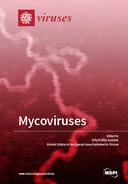Explore

A virus (from the Latin word ‘v?rus’ meaning ‘venom’ or ‘poison’) is a microorganism invisible to the naked eye. Viruses can multiply exclusively by entering a cell and using the cell’s resources to create copies of themselves. As the origin of their name suggests, viruses are generally considered dangerous, harmful and often deadly. Some of the most well-studied and widely known viruses, such as HIV and influenza, infect humans. However, viruses can also infect animals, plants and microorganisms, including fungi. Many fungi are medically, ecologically and economically significant, for example, causing diseases to humans, plants and insects or being used in industry to produce bread, cheese, beer and wine. Viruses that infect fungi are called mycoviruses (from the Greek work ‘myco’, meaning ‘fungus’). Mycoviruses do not cause harm to or kill the infected fungus; in contrast, they are ‘friendly’ viruses and we can utilize them to control the growth, pathogenicity and toxin production of fungi. This book describes a range of different mycoviruses and their geographical distribution, transmission and evolution, together with their effects on the fungal hosts and how these are brought about.
This book is included in DOAB.
Why read this book? Have your say.
You must be logged in to comment.
Rights Information
Are you the author or publisher of this work? If so, you can claim it as yours by registering as an Unglue.it rights holder.Downloads
This work has been downloaded 317 times via unglue.it ebook links.
- 207 - pdf (CC BY-NC-ND) at Unglue.it.
Keywords
- A. fumigatus
- A. nidulans
- A. niger
- A. thermomutatus
- Alphapartitivirus
- antiviral
- ash dieback
- Aspergillus
- Aspergillus fumigatus chrysovirus
- Aspergillus fumigatus partitivirus-1
- Aspergillus fumigatus tetramycovirus-1.
- Beauveria bassiana
- biocontrol
- Biological control
- Botrytis cinerea
- Botrytis cinerea mymonavirus 1
- brown rot
- Brunchorstia pinea
- capsid protein
- capsid structure
- Castanea sativa
- Chalara fraxinea
- chestnut blight
- chrysovirus
- conidiogenesis
- conifers
- Cryphonectria parasitica
- database mining
- dicer
- double-stranded RNA virus
- dsRNA
- dsRNA mycoviruses
- dsRNA virus
- endornavirus
- Entomophthora
- Entomophthoromycotina
- Ethiopia
- Evolution
- fungal virus
- fungal viruses
- Fusarium head blight
- fusarivirus
- gemycircularvirus
- genomic structure analysis
- horizontal virus transmission
- Hymenoscyphus pseudoalbidus
- hypervirulence
- hypovirulence
- hypovirus
- infection cushion
- invasive species
- isogenic
- killer system
- killer toxin
- Leptosphaeria biglobosa quadrivirus
- Magnaporthe oryzae. chrysovirus 1
- mitochondrion
- mitovirus
- multiplex PCR
- Mycorrhizal fungi
- mycovirus
- Mymonaviridae
- n/a
- Narnaviridae
- Partitivirus
- PcV
- phylogeny
- polymycovirus
- populations study
- Prunus
- PsV-F
- recombination
- Rhizoctonia solani AG-1 IA
- Rhizophagus
- rice blast fungus
- RNA genome
- RNA silencing
- RnQV1
- Saccharomyces paradoxus
- sclerogenesis
- Sclerotinia minor
- ScV-L-A
- selection pressure
- Sequencing
- small RNA
- ssRNA
- stone fruit
- Totiviridae
- totivirus
- transmissibility
- Transmission
- tRFs
- Trichoderma atroviride
- Tymovirales
- victorivirus
- viral lineage
- virus discovery
- virus evolution
Links
DOI: 10.3390/books978-3-03897-997-5Editions


